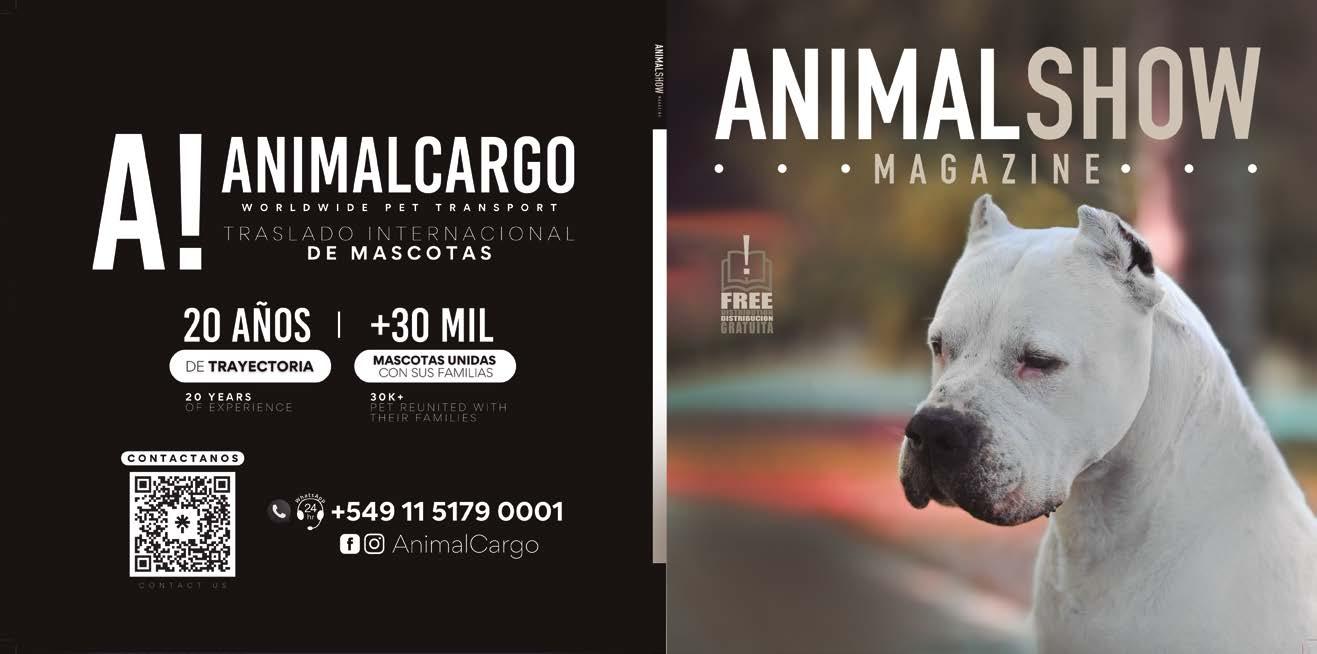






































Favio D. Cangiano / +54 9 11 5179 0001 favio@animalcargo.com
Augusto Peñalva / +54 9 11 23273835 augusto@animalcargo.com
Jeanette Lacour / +54 9 11 3307 1335 sweetsundayphoto@gmail.com
Pablo Pincheiro / +54 9 34 1690 9597 fotodogs@hotmail.com Yas Houdely / +56999973249 yas.houdely@gmail.com
Jeanette Lacour
José Maria Muñoz / IG @jmmunozpinturas
magazine@animalcargo.com

DISEÑO EDITORIAL / EDITORIAL DESIGN
Jeanette Lacour / Jannephoto sweetsundayphoto@gmail.com www.animalshowmagazine.com facebook.com/AnimalShowMagazine
REVISTA DIGITAL / DIGITAL MAGAZINE
IMPRENTA / PRINTER
Pausa impresores SRL Anatole France 360 - Sarandi Impresa Noviembre 2022
Confiar en el tiempo… no se puede ser ligeros a la hora de adjudicar un juicio de valor. En tiempos de turbulencia, donde prevalece la insensatez y el que grita más fuerte quiere tener la razón, donde se quieren obtener resultados inmediatos, las consecuencias en el largo plazo pueden ser graves.
Es responsabilidad de todos darnos la oportunidad de tomar decisiones sin apresurarnos, sin sesgos, con respeto, y constructivas; volver a explicar que detrás de cada raza existe un propósito y entenderlo.
Hay una historia, un estándar, una función, y no es el producto del libre albedrío, sino de muchos años de observación, esfuerzo y cuidado dedicado por especialistas y verdaderos amantes de los perros. Los perros de raza son parte de nuestra historia y no hay nada más lindo que permitir su coexistencia.
Muchas gracias Martín Parapar, Ernesto Crescenti y Eugenio Aguiló por su aporte en esta edición #14, y a todos los que participan y nos acompañan a volver a hacer realidad esta edición impresa. A disfrutarla!
Trust in time... one cannot be thoughtless when it comes to deal out in judgment.
In times of turbulence, where foolishness prevails and whoever shouts the loudest feels to be right, where immediate results are wanted, the long-term consequences may be serious.
It is everyone’s responsibility to give us the opportunity to make decisions without rushing, without bias, with respect, and constructively; reexplain that behind each breed there is a purpose and understand it. There is a history, a standard, a function, and it is not the product of free will, but of many years of observation, effort and dedicated care by specialists and true dog lovers. Purebred dogs are part of our history and there is nothing more beautiful than allowing their coexistence.
Many thanks to Martín Parapar, Ernesto Crescenti and Eugenio Aguiló for their contribution in this edition #14, and to all those who participate and join us in making this printed edition a reality again.
Enjoy!
Augusto Peñalva ...............................
Limitación de responsabilidad: Animal Show Magazine no acepta ninguna responsabilidad por la exactitud, el contenido, la integridad o la fiabilidad de la información contenida en cada uno de los anuncios de terceros. / Disclaimer: Animal Show Magazine does nor accept any responsibility or liability for the accuracy, content, completeness, legality or reliability of the contained on each of the third party advertisement.




























 Martin Parapar
Martin Parapar

Mi nombre es Martin Parapar y soy propietario del criadero Do Yel Dogos Argentinos. Me inicié en la raza por esas casualidades de la vida. Un vecino tenía una hembra que me gustaba mucho y cuando tuvo cría compré mi primer hembra. Esto fue en el año 1998 y desde entonces esta raza me apasiona, hasta llegar a ser una parte fundamental de mi vida.
En este largo camino, he conocido a mucha gente y a muchísimos ejemplares, pero sinceramente creo que fue un perro el que marcó mi camino en la crianza de esta raza. Fue un antes y un después de conocer al Indio del Litoral.
Personalmente busco en la crianza mantener un fenotipo que conocí y que mantengo presente en mi cabeza. Un dogo potente, rústico, un atleta, que como dijo su creador, es más de presa que de carrera. La cabeza y su expresión son
fundamentales en este fenotipo que intento mantener en el tiempo, por supuesto, trabajando sobre el conjunto del perro, pero sin perder esa característica tan única que lo identifica. Así como también es muy importante su temperamento; el Dogo debe ser muy noble y valiente, otra particularidad muy importante de la raza y que la hace tan especial.
Luego de tantos años de trabajo ininterrumpido siento que el esfuerzo y la pasión invertida han valido la pena. Con gran cantidad de ejemplares campeones, y muchos otros representando a nuestra raza en el exterior, siento que elegí el camino correcto.
Actualmente hay Dogos del Do Yel en casi toda AméricaLatina, en Norteamérica, muchos países de Europa, China, Corea e incluso en Dubái siendo el único Dogo Argentino que viajó de Argentina a ese país.
Sin duda aún queda mucho para trabajar y mucho más para mejorar pero mi objetivo es nunca perder este fenotipo. Espero poder cumplir y seguir trabajando en esta hermosa y única raza Argentina.


My name is Martin Parapar and I am the owner of the Do Yel Dogos Argentinos kennel.
A neighbor had a female Dogo that I liked a lot and with the next offspring of the bitch, I bought my first female. This was in 1998 and since then I have been passionate about this breed, until it has become a fundamental part of my life. On this long road, I have met many people and many specimens, but I sincerely believe that it was a dog that marked my path in the breeding of this breed. The turning point was after meeting Indio del Litoral.
Personally, I seek in breeding to maintain a phenotype that I knew and that I keep present in my head. A powerful, rustic mastiff, an athlete, who, as his creator said, is more about prey than racing. The head and its expression are essential in this phenotype that I try to maintain over time, of course, working on the
whole dog, but without losing that unique characteristic that identifies it. Just as its temperament is also very important; The Dogo must be very noble and brave, another very important attribute of the breed that makes it so special. After so many years of uninterrupted work, I feel that the effort and passion invested have been worth it. With a large number of champions, and many others representing our breed abroad, I feel that I have chosen the right path.
Currently there are Dogos of Do Yel Kennel in almost all of Latin America, in North America, many countries in Europe, China, Korea and even in Dubai, being the only Dogo Argentino that traveled from Argentina to that country.
Without a doubt, there is still a lot to work on and much more to improve, but my goal is focused on preserving this phenotype. It is my commitment to continue working on this beautiful and unique Argentine breed.
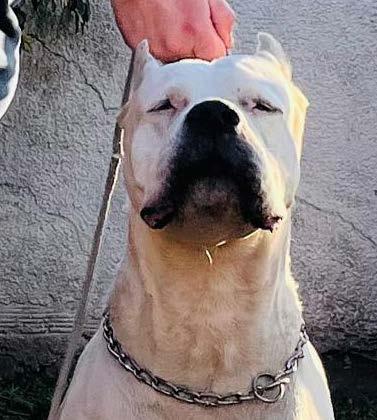 Martin Parapar
Martin Parapar













Mi nombre es Ernesto Crescenti, soy criador, expositor, y juez de la Raza Dogo Argentino Soy cazador y propietario del criadero DEL CAPANGA. El Dogo argentino como todas las razas tiene una función específica y esa función es la caza mayor.
Afortunadamente esta actividad se practica en Argentina y en otras partes del mundo, poniendo a prueba de manera constante la funcionalidad de estos perros. La cacería con Jauría o Monteria Criolla, se practica en diversas topografías y terrenos, cómo puede ser un monte cerrado en la provincia de San Luis o en La Pampa,los pajonales bonaerenses de la Bahía Samborombón, los diversos paisajes patagónicos, las sierras, la cordillera o la
selva.
El Dogo Argentino es un perro que se adapta a todos los ambientes y está diseñado para poder cazar y cumplir su función en cualquier terreno.
Existen además diferentes modalidades de caza, ya sea caminando junto a los perros, a caballo o en vehículos, situaciones a las cuales ellos deben adecuarse.
En todos los casos los perros deben ser capaces de cumplir con todos los aspectos y etapas de la cacería, ya sea en la búsqueda, al darle alcance y al hacer presa.
Para esto fundamental la educación de los perros, el Dogo Argentino es un perro de Jauría, por lo tanto debe ser dócil, manso y sociable, ya sea con sus congéneres como con otros animales salvajes y domésticos,
solo tiene que atrapar a la presa e ignorar a todos los demás animales. La principal presa es el jabalí.
Las jaurías están compuestas, por lo general, por 4 a 8 perros. Es muy común en nuestro país y en el mundo que las jaurías estén integradas por Dogo Argentino puros y por perros mestizos o de razas más veloces para poder dar alcance más fácil a la presa, denominados normalmente punteros.
Tuve la suerte de cazar en diferentes puntos del país y en otros lugares del mundo, y he comprobado qué actualmente hay muchos ejemplares Dogo Argentino que cumplen perfectamente la función para la cual fueron creados originalmente, y esto es sin duda fundamental para la
subsistencia de nuestra raza, y para la selección.
El Dogo Argentino es UNO solo y por lo tanto hay que ser muy estrictos en la selección, lo lógico es que un Dogo Argentino de calidad sea capaz de cazar y a la vez tener excelentes resultados en los show de Estructura y Belleza.

Es común ver que los perros que se usan para cazar, no cumplen con el estándar o ver que los perros que ganan Exposiciones no son llevados al campo para cumplir con su función. Lamentablemente esto genera dos tipos de perros diferentes pero ninguno completo. Por eso es fundamental, a mi parecer, que el Criador en nuestra raza tenga siempre muy presente la funcionalidad.

My name is Ernesto Crescenti, I am a breeder, exhibitor, and judge of the Dogo Argentino Breed. I am a hunter and owner of the DEL CAPANGA kennel.
The Argentine Dogo, like all breeds, has a specific function and that function is big game hunting. Fortunately, this activity is practiced in Argentina and in other parts of the world, constantly testing the functionality of these dogs.
Pack hunting or Monteria Criolla, is practiced in different topographies and terrains, such as in a thick

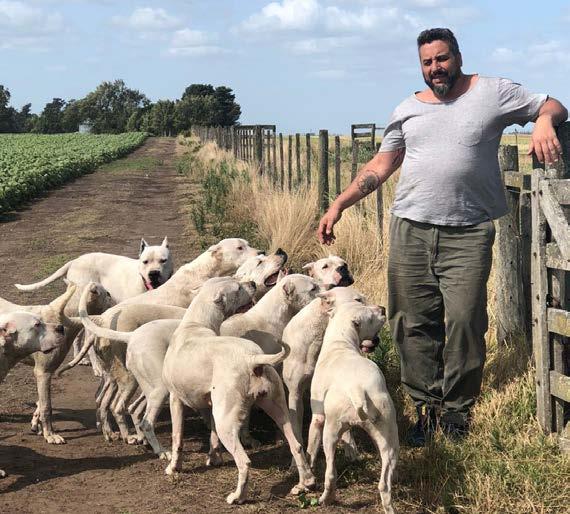

forest in the province of San Luis or La Pampa, the Buenos Aires’ grasslands of the Samborombón Bay, the diverse Patagonian landscapes, the hills, the mountain range or the jungle. The Dogo Argentino is a dog that adapts to all environments and is designed to be able to hunt and fulfill its function in any terrain. There are also different types of hunting, whether walking with the dogs, on horseback or in vehicles, situations to which they must adjust.
In all cases, the dogs must be able to comply with all aspects and stages of the hunt, whether in the search, when reaching and when preying.
For this, the education of dogs is fundamental, the Dogo Argentino is a pack dog, therefore it must be docile, meek and sociable, either with its congeners as with other wild and domestic animals, it only has to catch the prey and ignore all the other animals. The main prey is the wild boar.
Packs are generally made up of 4 to 8 dogs. It is very common
in our country and in the world for packs to be made up of pure Dogo Argentino and mix-breed dogs or faster breeds to be able to reach the prey more easily, normally called pointers.
I was lucky enough to hunt in different parts of the country and in other parts of the world, and I have verified that there are currently many Dogo Argentino specimens that perfectly fulfill the function for which they were originally created, and this is undoubtedly essential for the survival of our breed, and for selection.
The Dogo Argentino is only ONE and therefore it is necessary to be very strict in the selection; A quality Dogo Argentino must be able to hunt and at the same time have excellent results in the Structure and Beauty shows.
It is very common to see that the dogs used for hunting do not meet the standard or to see that
the dogs that win at Shows are not taken to the field to fulfill their function. Unfortunately, this generates two different types of dogs but neither complete.
That is why it is essential, in my opinion, that the Breeder in our breed always keep functionality very much in mind.














El doctor Eugenio Aguiló ha estado ligado desde muy joven a la cinofilia.
Comenzó a participar en exposiciones durante el año 1968, y aprobó como juez de su raza Boxer a los 22 años de edad y 10 años más tarde obtuvo el título de Juez All Rounder. En el año 2023 cumplirá 40 años como juez FCI de todas las razas. Además, ha juzgado en exposiciones mundiales en México, Brasil y Argentina y en numerosas exposiciones de la Sección de la Américas y el Caribe y en las de SICALAM, actuado como juez en más de treinta países y ha tenido una larga carrera dirigencial en su país. Recientemente lanzó un libro de su autoría “Las Claves del Juzgamiento Canino”, obra que él define como un “modesto legado para las nuevas generaciones”.

¿Cómo se inicia en la cinofilia?
- Mi pasión y mi amor por los perros arranca desde muy pequeño. La primera exposición que presencié fue cuando tenía 8 o 9 años, y de ahí en adelante mi madre me llevaba cada vez que descubría en el diario los avisos de las exposiciones. Como vivía con abuelos y en departamento no podía tener perros, pero me
compraban los pocos libros que se comercializaban y yo los leía una y otra vez. Mi raza favorita desde siempre fueron los Boxer, ya que en el parque que frecuentaba conocí una perra leonada llamada “Dadi”, con la que jugaba y aprendí a quererla y hasta entenderla. Fue durante el año 1968 que tuve mi primera perra y comencé a participar en
las exposiciones. Yo siempre aclaro que “no soy un Médico Veterinario que se dedicó a los perros. Más bien soy un perrero que decidió estudiar Veterinaria para cuidar mis perros”.
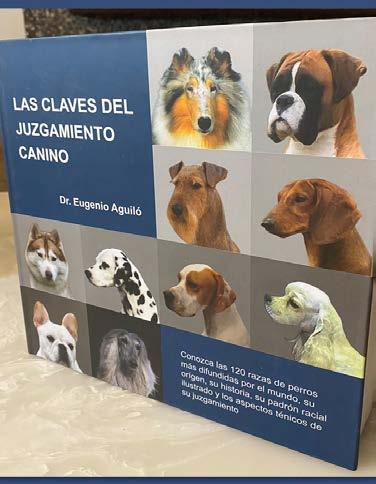
¿Cómo afronta el desafío de juzgar en una Mundial?
- A lo largo de mi vida he asistido a muchas mundiales, pero como juez debuté muy joven, con solo 34 años, en la mundial de México de 1984, lo que para mí fue un hito inolvidable para mi carrera. Luego juzgué en las mundiales de Argentina en 1993 y en el 2005 y en la de Brasil en el año 2004, oportunidad en que juzgué el final del grupo 4. Huelga decir que siempre es un momento trascendente y un gran honor integrar esos paneles de jueces en que se dan cita grandes figuras de nuestra actividad, además de percibir la evolución de las mundiales. Me refiero a la calidad de perros, en cantidad y variedad de razas, pero por sobre todo por el nivel de producción de estos eventos en que los avances han sido considerables. De hecho, Las

Eugenio Aguiló, veterinarian, has been connected from a very young age to the dog-fancy. He began to participate at dog shows during the year 1968, and was approved as a judge of his Boxer breed at 22 years of age and 10 years later he obtained the Judge All Rounder title. In the year 2023 he will be 40 years old as an FCI judge of all breeds. In addition, he has judged at WDS in Mexico, Brazil and Argentina and in numerous shows of the Americas and the Caribbean Section and in those of SICALAM, acted as a judge in more than thirty countries and has had a long leadership career in his country. He recently released a book of his authorship “The Keys to Canine Judgment”, a work that he defines as a “modest legacy for new generations.” How did you start in the dogfancy?
- My passion and my love for dogs started from a very young age. The first exhibition I attended was when I was 8 or 9 years old, and from then on my mother would take me whenever she discovered the advertisements for the dog shows in the newspaper. Since I lived with my grandparents and in an apartment, I couldn’t have dogs, but they bought me the few books that were available back then and I read them over and over again. My favorite breed has always been the Boxer, since at the park I frequented I met a fawn
dog called “Dadi”, with whom I played and learned to love her and even understand her. It was during the year 1968 that I had my first dog and I began to participate in the exhibitions. I always clarify that “I am not a Veterinary Doctor who dedicated himself to dogs. Rather, I am a dog owner who decided to study Veterinary Medicine to take care of my dogs.”
How do you face the challenge of judging at a WDS?
- Throughout my life I have attended many WDS, but as a judge I made my debut very young, at only 34 years old, in the 1984 WDS in Mexico, which for me was an unforgettable milestone in my career. Then I judged at WDS in Argentina in 1993 and in 2005 and in Brazil in 2004, when I judged the final of Group 4.
Needless to say that it is always a transcendent moment and a great honor to integrate those panels of where prominent judges of our activity meet, in addition to perceiving the evolution of the WDS. I am referring to the quality of dogs,
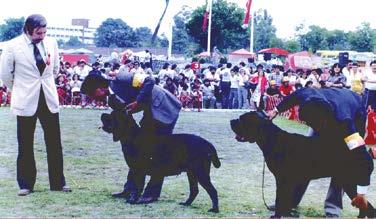
in quantity and variety of breeds, but above all because of the level of production of these events in which progress has been considerable. In fact, the first WDS I attended was the one in Spain, in 1983 and if we compare it with the current ones there is an extraordinary difference. As for the one we will have in Brazil in 2022, I am very honored to have been invited, and I have no doubt that it will be a great event, and as a judge it will be another opportunity for growth and experience. What is the most remarkable thing about having a WDS in our continent?
- It is really very important, but it is difficult to get an FCI General Assembly to designate any of our countries, since the applications are scarce due to what is required in costs and organizational capacity of an event of this magnitude; It is difficult to face. In addition to the problem of the distance to attend the competition from other continents, such as Europe or Asia, have been added the tremendous difficulties that airlines pose today, a factor that prevents many from being able to attend.
Additionally, due to the size of the dog shows of our continent,
la primera mundial a la que asistí fue la de España, en el año 1983 y si la comparamos con las de la actualidad hay una diferencia extraordinaria. En cuanto a la que tendremos en Brasil este 2022, me siento muy honrado con que me hayan invitado, y no me cabe duda de que será un gran evento, y como juez será otra posibilidad de crecimiento y experiencia. ¿Qué es lo más destacable de tener una mundial en nuestro continente? - Es realmente muy importante, pero es difícil de conseguir que una Asamblea General de la FCI designe

alguno de nuestros países, ya que las postulaciones son escasas debido a lo que demanda en costos y capacidad organizativa de un evento de esta magnitud es difícil de afrontar. Además, al problema de la distancia para que asistan a competir desde otros continentes, como por ejemplo de Europa o de Asia, se han agregado las tremendas dificultades que hoy ponen las líneas aéreas, factor que impide a muchos poder asistir. Adicionalmente, por el tamaño de las cinofilias de nuestro continente, creo que en la actualidad los únicos con capacidad real de afrontar un desafío de esta magnitud son Brasil y México. Ojalá


I believe that currently the only ones with real capacity to deal with a challenge of this magnitude are Brazil and Mexico. Hopefully this will change in the future, although I see it more difficult every day. Lastly, for our breeders and exhibitors, attending a WDS in their continent, even if only as spectators, is something fundamental and I always recommend that the judges make the effort and attend, because you learn a lot. By the way, it is always an unforgettable and invaluable experience.
You recently published a book aimed primarily at Judges, what was your motivation and what could you highlight from this publication?
- The book “The Keys of Canine Judgment” is an idea that I had for many years, so I was compiling material and writing until I was given the opportunity to materialize this project while being a diplomat in India, a country in which I was locked up for many months due to the COVID 19 pandemic. So, time
allowed me to capture all these in my book, although I never imagined that I would write, edit and design a work with more than 1,000 pages. When I finished it, I must admit that it is not easy to describe the joy and feelings of seeing something that is very important to me, being materialized, since I passed on my experience and knowledge acquired over more than fifty years of activity. A longcherished dream was fulfilled.
It is a book for dog owners written by a dog owner and -modestly- I hope that it becomes a contribution for the judges, especially for the newest ones and for those who are being trained. Although I think it will also be useful for serious breeders who work to improve breeds and for professional handlers, as it will help them to understand what judges generally look for in each breed. Allow me to digress: not all breeds should be presented in the same way.
Since the book was presented in Chile, when I had the presence of the president of the FCI
Judges Commission, my friend Adrián Landarte, I have received very good comments, which makes me very happy.
How do you see the current reality and the future of canine judging?
- The activity of judging, -which for me is a true passion-, is getting more complex every day. Holding several events during the same weekend, gives the judges less time to evaluate and classify the specimens. The competition is tough and I think that the fact that many people make a living from this, harms coexistence. As for the judging itself, the health and well-being of the specimens is becoming more important every day, something that the FCI warns frequently. With regard to the career of a judge, I see many people who would like to advance very quickly and who find it difficult to accept the deadlines FCI imposes, although for me they are the correct ones. The judge is formed by judging, it is done by studying a lot, it is done by seeing many specimens, it is done by observing the judging of the oldest and most
experienced judges. In short, training lasts a lifetime. Finally, knowledge about each breed must be very clear in order to influence their improvement. Judging is much more than memorizing a standard, which anyone can do. It is understanding the breed, knowing why it was created and is bred for, and all of this requires study and the will to constantly improve.
Dr. Eugenio Aguiló Veterinario Juez All Rounder
que a futuro esto cambie, aunque cada día lo veo más difícil. Por último, para nuestros criadores y expositores, asistir a una mundial en su continente, aunque sea solo como espectadores, es algo fundamental y a los jueces les recomiendo siempre que hagan el esfuerzo y asistan porque se aprende mucho. Por cierto, siempre es una experiencia tan inolvidable como invaluable.

Usted recientemente publicó un libro orientado fundamentalmente a jueces, ¿cuál fue su motivación

y que podría destacar de esta publicación?
- El libro “Las Claves del Juzgamiento Canino” es una idea que tenía desde hace ya muchos años, por lo que fui recopilando material y escribiendo hasta que se me dio la oportunidad de concretar este proyecto estando como diplomático en la India, país en el que estuve muchos meses encerrado por la pandemia del COVID 19. Entonces, el tiempo me permitió plasmar esto en mi libro, aunque nunca imaginé que llegaría a escribir, editar y diseñar una obra con más de 1.000 páginas. Cuando la finalicé, admito que no es fácil describir la alegría y los sentimientos de ver materializado algo que para mí es muy importante, ya que transmití mi experiencia y conocimientos adquiridos por más de cincuenta años de actividad. Se cumplía un sueño largamente acariciado. Es un libro para perreros escrito por un perrero y –modestamente- espero que se constituya en un aporte para los jueces, sobre todo para los
más nóveles y para quienes se están formando. Aunque creo que también será útil para los criadores serios que trabajan por mejorar las razas y para los handlers profesionales, pues les servirá para comprender lo que generalmente los jueces buscan en cada raza. Permítame hacer una digresión: no todas las razas deben presentarse de la misma forma.Desde que el libro fue presentado en Chile, oportunidad en que conté con la presencia del presidente de la Comisión de Jueces de la FCI, mi amigo Adrián Landarte, he recibido muy buenos comentarios, lo que me tiene muy contento y en estado de regocijo. ¿Cómo ve la realidad actual y el futuro del juzgamiento canino? - La actividad de juzgar, -que para mi es una verdadera pasión-, la veo cada día más compleja. Ello, porque al realizar varios eventos en un mismo fin de semana, los jueces cada día tienen menos tiempo para evaluar y clasificar a los ejemplares. La competencia
es dura y creo que el hecho que mucha gente viva de esto perjudica la convivencia. En cuanto al juzgamiento propiamente tal, cada día es más importante la salud y el bienestar de los ejemplares, algo que la FCI advierte frecuentemente. Con respecto a la carrera de juez, veo mucha gente que quisiera avanzar muy rápido y que les cuesta aceptar los plazos que impone la FCI, aunque para mí son los correctos. El juez se forma juzgando, se hace estudiando mucho, se hace viendo muchos ejemplares, se hace observando el juzgamiento de los más antiguos y experimentados. En síntesis, la formación dura toda una vida. Por último, se deben tener muy claros los conocimientos acerca de cada raza para incidir en la mejora de las mismas. Juzgar es mucho más que memorizar un estándar, cosa que cualquier persona puede lograr. Es entender la raza, saber para qué fue creada y es criada, y todo ello requiere estudio y la voluntad de perfeccionarse permanenteme.








A nivel mundial, la tendencia indica que los animales se incorporan cada vez más a los territorios y los espacios de influencia de sus “humanos”: hoy, los bares y restaurants se adaptan para recibirlos, los medios de transporte públicos los incluyen y en locales comerciales está bien visto “que te acompañe tu mascota”.
Si había un espacio en donde faltaba este tipo de inclusión eran los aeropuertos: cuando uno llegaba con sus mascotas las mismas ya estaban en sus contenedores y el contacto entre ellos y sus dueños ya era casi nulo. Incluso para aquellos que se acercan a despedir a un familiar o amigo - o que van a
recibirlo - debían dejar a sus animales en casa porque los aeropuertos eran algo hostiles para ellos. Hace varios meses, el Aeropuerto Internacional Ministro Pistarini - en Ezeiza, Buenos Aires - es el escenario principal de una transformación que se está dando a nivel nacional: adaptar sus espacios existentes - y creando nuevospara animales.
Esto tiene que ver con una tendencia que va hacia la inclusión de las mascotas en la dinámica personal o familiar de la gente. Se trata de incluirlos en momentos trascendentales - como despedir a un miembro de la familia que emigra - pero también para que la espera
para un traslado o mudanza suceda con mayor amabilidad y respeto hacia ellos.
Animal Cargo es la empresa encargada de realizar los primeros cambios que el Aeropuerto de Ezeiza irá presentando en sociedad: en primer lugar, se están desarrollando plazas pet friendly - en las áreas de Arribos y Embarques - que incluyen puestos de hidratación, duchas y elementos de higiene como bolsas, cestos, etc. Las plazas tienen un sector central de 5 metros con duchas y puntos de hidratación. El sector se completa con espacios laterales con césped y un PuntoCan con bolsas y cesto especial para



Worldwide, the trend implies that animals are increasingly incorporated into the territories and spaces of influence of their “humans”: today, bars and restaurants are adapted to receive them, they are included in public transportation means and in local stores it is well seen “that your pet accompanies you”.
If there was a space where this type of inclusion was lacking, it was airports: when you arrived with your pets, they were already in their containers and contact between them and their owners was almost zero. Even for those who are about to greet a family member or friend - or who are going to receive one - they had to leave their animals at home because airports were somewhat hostile to them. For several months, the Ministro Pistarini International Airport - in Ezeiza, Buenos Aires - has been the main stage of a transformation that is taking place at the national level: adapting its existing spaces - and creating new ones - for animals. This has to do with a trend
towards the inclusion of pets in people’s personal or family dynamics. It is about including them in transcendental moments - such as saying goodbye to a family member who emigrates - but also so that the wait for a transfer or move happens with greater kindness and respect towards them.
has the necessary lighting.
Animal Cargo is the company in charge of making the first changes that Ezeiza International Airport will be presenting to society: first, pet-friendly places are being developed - in the Arrivals and Departures areas - that include hydration stations, showers and hygiene such as bags, bins, etc. The pet friendly area has a central sector of 5 meters with showers and hydration points. The sector is completed with lateral spaces with grass and a PuntoCan with bags and a special bin for animal waste. This space is available to be used without a time limit, and more than 4 animals can enjoy it simultaneously. It is worth clarifying that this service is available 24 hours a day since it
“The proposal aims to give space to all family members: humans and animals. We believe that this synergy, that this coexistence must go further and further and ensure that all the spaces we inhabit include our pets. It is not easy to adapt but we have to try: with care, with respect and with a lot of professionalism, this first experience at Ezeiza International Airport was possible, which will surely be replicated in all airports in the country and the idea is to regionalize it” says Favio Cangiano, founder and CEO of Animal Cargo.
It is now possible to access these spaces by the Arrivals and Boarding areas - for the minutes before takeoff, having passed through Immigration and the last Customs controls - which will allow the animals to be more accompanied, less stressed and tranquil for the journey that awaits them.
los residuos de los animales. Este espacio está disponible para ser utilizado sin límite de tiempo, pudiendo disfrutar el espacio más de 4 animales en simultáneo. Vale la pena aclarar que este servicio está disponible las 24 hs ya que cuenta con la iluminación necesaria.

despegue, habiendo pasado por Migraciones y por los últimos controles de Aduana - que permitirán que los animales estén más acompañados, menos estresados y más tranquilos para el viaje que les espera.
“La propuesta apunta a darle un espacio a todos los miembros de una familia: los humanos y los animales. Nosotros creemos que esta sinergia, que esta convivencia debe ir cada vez más allá y lograr que todos los espacios que habitamos, incluyan a nuestras mascotas. No es fácil adaptarse pero hay que intentarlo: con cuidado, con respeto y con mucho profesionalismo fue posible esta primera experiencia en Ezeiza que seguramente se replicará en todos los aeropuertos del país y la idea es regionalizarlo” afirma Favio Cangiano, fundador y CEO de Animal Cargo.
Ya es posible acceder a estos espacios en las áreas de Arribos y en el sector de Embarque - para los minutos previos al


